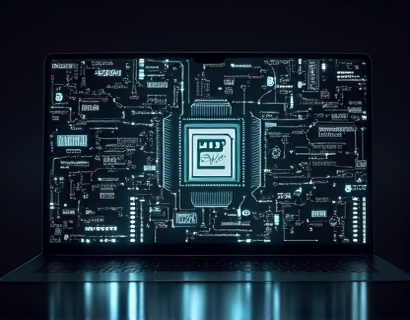Crypto AI Synergy: Revolutionizing Ucosystem Engagement Through Advanced Technology
The intersection of cryptocurrency and artificial intelligence (AI) is giving rise to a new era of digital transformation, particularly within user engagement within uecosystems. This synergy is not just a technological advancement but a paradigm shift that is redefining how businesses interact with their users. The integration of these two powerful technologies is creating advanced tools that enable companies to connect, grow, and innovate in ways previously unimaginable. This article delves into the transformative impact of crypto AI synergy on digital ecosystems, offering insights for tech professionals and enthusiasts looking to harness these technologies for superior user experiences and market leadership.
Understanding Crypto AI Synergy
Crypto AI synergy refers to the combination of blockchain technology and artificial intelligence to create more efficient, secure, and engaging digital experiences. Blockchain provides a decentralized and transparent platform for transactions, while AI brings intelligent algorithms that can analyze vast amounts of data to provide insights and automate processes. Together, they form a powerful toolkit for businesses aiming to enhance user engagement and operational efficiency.
The Role of Blockchain in Ucosystems
Blockchain technology underpins the uecosystem by ensuring transparency, security, and decentralization. In a uecosystem, blockchain serves as the foundational layer that enables trustless transactions without the need for intermediaries. This not only reduces costs but also increases the speed and reliability of transactions. For users, this means a more seamless and secure experience when interacting with digital services.
AI in Ucosystem Engagement
AI plays a crucial role in enhancing user engagement by providing personalized and intelligent interactions. Through machine learning algorithms, AI can analyze user behavior, preferences, and patterns to deliver tailored content and recommendations. This level of personalization not only improves user satisfaction but also increases the likelihood of user retention and engagement. AI-driven chatbots and virtual assistants further enhance the user experience by providing instant and accurate support.
Advanced Tools for Business Innovation
The integration of crypto and AI offers businesses a suite of advanced tools to innovate and stay competitive. These tools include smart contracts, which automate and enforce contractual obligations with precision and transparency, and predictive analytics, which use AI to forecast market trends and user behavior. By leveraging these tools, businesses can optimize their operations, reduce risks, and create more value for their users.
Smart Contracts: Automating Trust
Smart contracts are self-executing contracts with the terms of the agreement directly written into code. They run on blockchain networks, ensuring that all parties adhere to the agreed terms without the need for a central authority. In a uecosystem, smart contracts can automate various processes such as payments, content delivery, and access control. This automation not only streamlines operations but also builds trust among users by ensuring transparency and accountability.
Predictive Analytics: Insights for Growth
Predictive analytics powered by AI can process large datasets to identify patterns and trends that human analysts might miss. For businesses, this means gaining valuable insights into user behavior, market dynamics, and potential opportunities. By anticipating user needs and market shifts, companies can proactively adjust their strategies to stay ahead of the competition. In a uecosystem, predictive analytics can help in optimizing content delivery, enhancing user experiences, and identifying new revenue streams.
Enhancing User Experience through AI-Driven Personalization
One of the most significant benefits of AI in uecosystems is the ability to deliver highly personalized experiences. AI algorithms can analyze vast amounts of user data to understand individual preferences and behaviors. This data is then used to curate content, recommend products, and tailor interactions in real-time. For instance, a streaming service can use AI to suggest shows based on a user's viewing history and ratings, creating a more engaging and satisfying experience.
Real-Time Personalization
Real-time personalization is a key aspect of AI-driven user engagement. By processing data in real-time, AI can adapt the user experience on the fly. For example, an e-commerce platform can adjust product recommendations based on a user's current browsing and purchase history. This level of responsiveness not only keeps users engaged but also increases the chances of conversion. In a uecosystem, real-time personalization can be extended to various touchpoints, from social media interactions to in-app notifications.
Building Trust and Security with Blockchain
Trust and security are paramount in any digital ecosystem. Blockchain technology addresses these concerns by providing a secure and transparent platform for transactions. Every transaction on a blockchain is recorded in a block and linked to the previous block, creating an immutable ledger. This makes it extremely difficult for any party to alter the data without detection. For users, this means a higher level of security and confidence in the platform they are using.
Decentralized Identity Management
Decentralized identity management is another area where blockchain shines. Traditional identity management systems are centralized, making them vulnerable to breaches and misuse. Blockchain-based identity solutions allow users to control their own identities, storing credentials in a secure and private manner. This not only enhances security but also gives users more control over their personal information. In a uecosystem, decentralized identity management can streamline user onboarding and authentication processes, reducing friction and improving the overall user experience.
Fostering Innovation through Collaboration
The crypto AI synergy is not just about individual benefits but also about fostering a collaborative ecosystem where innovation thrives. By combining the decentralized nature of blockchain with the intelligent capabilities of AI, businesses can collaborate more effectively. Open-source projects and decentralized autonomous organizations (DAOs) are examples of how communities can come together to develop and improve technologies. This collaborative approach accelerates innovation and ensures that the ecosystem remains dynamic and responsive to user needs.
Open-Source Development
Open-source development is a cornerstone of the crypto AI ecosystem. By making code and protocols available to the public, developers can build upon existing work, leading to faster advancements and more robust solutions. This collaborative environment encourages transparency and accountability, as anyone can review and contribute to the codebase. For businesses, participating in open-source projects can provide access to cutting-edge technologies and a community of experts who can help refine and enhance their offerings.
Decentralized Autonomous Organizations (DAOs)
DAOs are community-driven organizations that operate through smart contracts on a blockchain. They allow members to propose, vote on, and execute decisions collectively, eliminating the need for a central authority. In a uecosystem, DAOs can be used to govern the development and direction of projects, ensuring that decisions are made in the best interest of the community. This democratic approach not only fosters innovation but also builds a strong sense of ownership and engagement among users.
Challenges and Considerations
While the crypto AI synergy offers numerous benefits, it also comes with its own set of challenges and considerations. One of the primary concerns is the regulatory landscape, which is still evolving and varies significantly across different regions. Businesses must navigate these regulations carefully to ensure compliance and avoid legal issues. Additionally, the technical complexity of integrating blockchain and AI requires skilled professionals and significant investment.
Regulatory Compliance
The regulatory environment for cryptocurrencies and AI is complex and often uncertain. Different countries have different laws and guidelines, and businesses operating in multiple jurisdictions must stay informed and adaptable. Compliance with regulations such as data protection laws (e.g., GDPR) and anti-money laundering (AML) regulations is crucial. Engaging with legal experts and staying updated on regulatory changes can help businesses navigate this landscape more effectively.
Technical Complexity
Integrating blockchain and AI technologies is technically challenging and requires a deep understanding of both fields. Businesses need to invest in skilled personnel or partner with technology providers who can handle the development and maintenance of these systems. Moreover, ensuring the scalability and performance of blockchain-based applications is essential to provide a smooth user experience. Continuous research and development are necessary to overcome these technical hurdles.
Future Prospects
The future of crypto AI synergy in uecosystems looks promising, with ongoing advancements and increasing adoption. As more businesses recognize the potential of these technologies, we can expect to see more innovative applications and integrations. The convergence of blockchain, AI, and other emerging technologies such as the Internet of Things (IoT) and 5G will further enhance the capabilities of digital ecosystems, leading to more seamless, secure, and personalized user experiences.
Emerging Trends
Several emerging trends are shaping the future of crypto AI synergy. One such trend is the rise of decentralized finance (DeFi), which leverages blockchain to create financial services without traditional intermediaries. AI can enhance DeFi platforms by providing more accurate risk assessments, fraud detection, and personalized financial advice. Another trend is the integration of AI-powered virtual and augmented reality (VR/AR) experiences within uecosystems, creating immersive and interactive user environments.
Sustainable Innovation
Sustainability is becoming an increasingly important factor in technological innovation. The crypto AI synergy can contribute to sustainable practices by optimizing resource usage and reducing waste. For example, AI can optimize energy consumption in data centers, while blockchain can facilitate transparent and verifiable supply chain management. By aligning technological advancements with sustainability goals, businesses can not only enhance user experiences but also contribute to a more sustainable future.
In conclusion, the integration of cryptocurrency and AI is revolutionizing user engagement within digital ecosystems. This synergy offers businesses advanced tools to connect, grow, and innovate, providing a competitive edge in the tech landscape. By embracing these technologies, companies can create more secure, personalized, and efficient experiences for their users, driving growth and market dominance. As the field continues to evolve, staying informed and adaptable will be key to harnessing the full potential of crypto AI synergy.











































